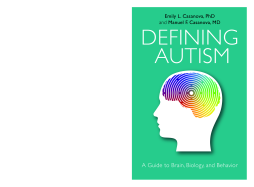
Additional Information
Book Details
Abstract
Offering a summary of the current state of knowledge in autism research, Defining Autism looks at the different genetic, neurological and environmental causes of, and contributory factors to autism. It takes a wide-ranging view of developmental and genetic factors, and considers autism's relationship with other conditions such as epilepsy.
Shedding light on the vast number of autism-related syndromes which are all too often denied adequate attention, it shows how, whilst autism refers to a single syndrome, it can be understood as many different conditions, with the common factors being biological, rather than behavioral.
Table of Contents
| Section Title | Page | Action | Price |
|---|---|---|---|
| Defining Autism: A Guide to Brain, Biology, and Behaviour by Emily L. Casanova and Manuel F. Casanova | 3 | ||
| 1. Kanner’s Conundrum and Bernie’s Biology | 9 | ||
| 2. The Brain in Autism | 27 | ||
| 3. The Genetics of Autism | 43 | ||
| 4. The Roles Environment Plays in Autism Susceptibility | 65 | ||
| 5. Regression in Autism | 101 | ||
| 6. Autism and Epilepsy | 121 | ||
| 7. The Neurodevelopmental Spectrum | 137 | ||
| 8. The Broader Autism Phenotype | 157 | ||
| 9. Autism, Intellectual Disability, and Genius | 173 | ||
| 10. Toward a definition \nof Autism | 193 | ||
| References | 211 | ||
| Subject Index | 249 | ||
| Author Index | 256 | ||
| Blank Page |
